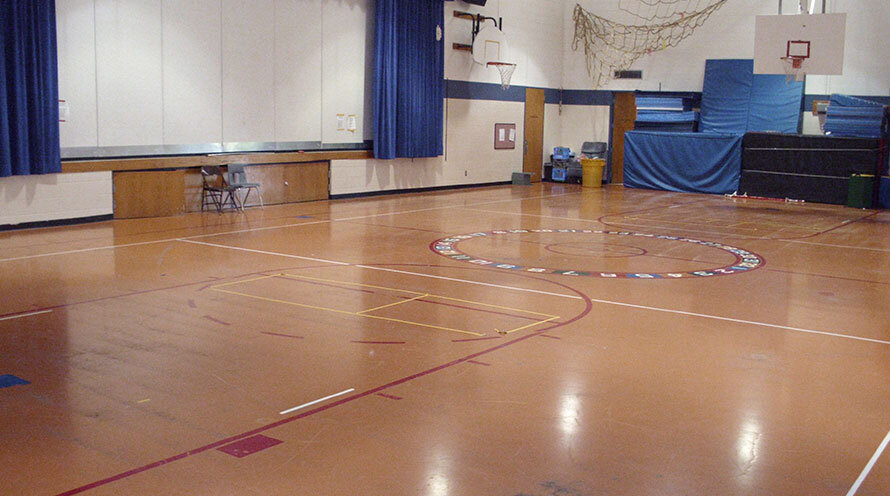
Mercury embedded in gym floors remains one of the most overlooked hazards in schools and athletic facilities across the United States. Although its presence is invisible to the naked eye, this toxic heavy metal can quietly release poisonous vapors, especially as the polyurethane matrix in which it is bound begins to deteriorate.
This is pronounced in warm, poorly ventilated spaces, significantly endangering the health of children, athletes, teachers, and maintenance workers who spend long hours in these environments.
Historical Context: Why Mercury Was Used in Flooring
Between the 1960s and the 1980s, many schools, athletic facilities, recreation centers, and even hospitals installed seamless polyurethane-based flooring systems. These products, including the widely popular and ubiquitous 3M Tartan floors, contained mercury compounds, usually phenyl mercuric acetate, which served to help the material cure evenly and quickly.
At the time, mercury’s leachability was not fully understood, and no regulatory framework existed to address its vapor emissions or require indoor testing. This oversight led directly to elemental mercury within the polyurethane matrix slowly off-gassing into indoor air environments.
The Science of Vaporization and Exposure Risks
Although mercury will slowly evaporate at room temperature, it is particularly problematic in warmer climates because, as the temperature rises, the rate of evaporation (vapor pressure) increases significantly. This means more mercury vapor is released from the same surface area in warmer conditions. For example, raising the temperature from 68°F to 86°F can more than double the mercury vapor concentration released by a floor.
This is further compounded by the fact that gymnasiums and multipurpose rooms often lack good ventilation, especially in older buildings, leading to the presence of potentially hazardous concentrations of mercury vapor.
Severe Health Effects of Mercury Inhalation
A direct result of exposure to unmitigated mercury vapor includes, among other things, nervous system damage and kidney damage, especially among young children, as their developing brains are more vulnerable to toxicity. As elevated levels of mercury vapors are inhaled, many exposed individuals can suffer from:
- Tremors
- Irritability
- Memory loss
- Fatigue
- Difficulty concentrating
In severe cases, kidney dysfunction and respiratory system damage can occur.
What makes this problem especially insidious is mercury vapor is colorless, odorless, and heavier than air. Consequently, concentrations often peak within a few feet of the floor, which is the breathing zone for many children during various physical activities.
How To Identify Potentially Hazardous Flooring
In addition to severe adverse health effects, the transparency and odorless nature of mercury vapor also create detection problems, and specialized sampling equipment is often necessary for definitive analysis. However, there are some initial steps you can take to determine if you are dealing with mercury-containing flooring in your building.
The first of these is to thoroughly review the building’s construction and renovation records. A cursory examination of either the architectural flooring drawings or the proprietary specifications sheets used in the building’s construction may reveal its presence. Proprietary specification sheets are especially helpful, as they identify the product and manufacturer used in the specific building materials (e.g., 3M Tartan floors).
Additionally, after checking the building’s construction and renovation records, you should also perform a direct physical inspection of the flooring itself. Many mercury-containing floors have a seamless, slightly rubbery texture, often tinted in bright colors like red, blue, or tan.
Professional Testing: Material and Air Sampling
If an analysis of the building’s construction records and visual clues lead you to suspect mercury is present, you can always accept them at face value and have the flooring remediated. However, if you would like definitive analytical results of the presence of mercury in your flooring materials, a professional assessment is recommended.
Testing for mercury flooring typically involves two steps. The first is to have technicians collect small, full-depth core samples of the flooring and submit them to a laboratory to determine total mercury content. This is often performed using EPA Method 7471A, which provides a reliable measurement of mercury concentration in parts per million (ppm). Results exceeding 20 ppm are considered a strong indicator of vapor emissions, which could pose a risk to the building occupants.
Secondarily, air sampling should be conducted in order to measure mercury vapor concentrations during typical use and under stress conditions, such as when the gym is heated or ventilation is turned off. Some states, including Minnesota and New Jersey, have published indoor air guidelines encouraging schools to take action if mercury vapor exceeds 750 nanograms per cubic meter (ng/m3) over an eight-hour average.
Remediation Option 1: Full Abatement and Removal
When contamination is confirmed, a professional risk assessment should be performed to weigh measured levels against health-based benchmarks. If the analysis shows air concentrations are near or above recommended exposure limits, or if renovations will disturb the flooring, full removal is the safest option.
Mercury abatement projects demand meticulous planning, as disturbing or cutting the floor can release significant amounts of vapor into the surrounding area. Mercury flooring abatement typically involves specialized containment systems constructed to isolate the work zone, as well as air filtration units equipped with activated carbon and HEPA filters to remove mercury before it spreads. Furthermore, workers wear protective suits, gloves, and respirators equipped with mercury vapor cartridges in addition to blood and urine monitoring to check for signs of mercury exposure.
After removal, clearance air testing is performed to confirm air concentrations have dropped to acceptable levels and surfaces are safe for public occupancy. The clearance air monitoring step is critical not only for liability purposes but also to ensure staff and students can safely return to the building.
Lastly, all removed materials are packaged in labeled containers, tracked through hazardous waste manifests, and transported to approved disposal facilities. If the flooring exceeds regulatory thresholds for mercury leachability in unlined, construction and demolition debris landfills under the Toxicity Characteristic Leaching Procedure (TCLP), it will be managed as hazardous waste under federal and state laws.
Remediation Option 2: In-Place Management and Encapsulation
In cases where full removal is not practical, either due to budget constraints or because a facility cannot be closed for extended periods, managing the hazard in place becomes the priority. Encapsulation is often the chosen method as it involves sealing the surface of the flooring with specialized coatings designed to suppress vapor emissions. This process, along with ventilation improvements, such as increased outdoor air exchange rates and continuous exhaust fans, can reduce mercury concentrations below health-based benchmarks.
However, it’s important to remember encapsulation requires regular monitoring to verify the mercury levels remain within safe limits over time. To achieve this, facilities often implement written management plans outlining how flooring will be maintained, how ventilation systems will operate, how often regular monitoring will occur, and how occupants will be protected during any repairs or renovations.
Also through this management process, facility managers ensure accidental exposures are avoided. Many unintentional exposures and extensive building contaminations occur during the renovation, refinishing, or repair of deteriorated mercury-embedded flooring systems, as these disturbance processes release microscopic mercury vapor and particulate matter into the air. Any work impacting mercury flooring systems must be avoided until it has been thoroughly tested by a professional.
A Case Study in Successful Abatement
Regardless of the approach selected, addressing mercury contamination requires a partnership with qualified professionals who understand both industrial hygiene and environmental regulations. Colorado Hazard Control (CHC) has become a trusted resource for schools, universities, and public agencies requiring assistance with mercury assessments and abatement, as we have firsthand experience with the complexities of these projects.
A major renovation at the United States Air Force Academy (AFA) Fieldhouse uncovered thousands of square feet of rubber athletic flooring containing mercury. What began as a straightforward flooring replacement project quickly evolved into an extensive hazardous materials abatement project when laboratory analysis revealed high concentrations of mercury in the flooring material.
CHC responded by establishing negative air containment systems to prevent vapor migration to occupied spaces, deploying high-capacity HEPA filtration units with activated carbon to scrub the air, and constructing decontamination chambers to allow workers to safely remove their protective clothing. These measures allowed the AFA to proceed with their renovations without risking mercury exposure to the site’s construction workers, Air Force cadets, and facility staff. This project has since become a model example of how to manage mercury abatement in an occupied, high-visibility environment without interrupting critical operations.
The Importance of Proactive Assessment
School leaders and facility managers who suspect their buildings may contain mercury flooring are encouraged not to wait for renovations to uncover the problem or for complaints to arise. Early assessment allows institutions to plan renovations or remediation strategies before vapor concentrations can harm building occupants.
Colorado Hazard Control offers a complete suite of services, including site assessments, access to industrial hygienists, project design and removal, and clearance testing. Our team can quickly mobilize to assess conditions and develop a clear, practical plan to protect your building occupants and ensure compliance with regulations.
Mercury in gym floors is a hidden legacy of past construction practices, but with proactive assessment and expert guidance, schools and athletic facilities can address this risk safely and responsibly. Doing so protects the health of students, staff, and future generations who rely on these spaces every day.
About Colorado Hazard Control
Colorado Hazard Control is the natural industrial, commercial and residential environmental solutions provider achieving the highest quality workmanship by focusing intensely on what we do best — health, safety, and environmental compliance. With locations in Denver, Colorado Springs and Pueblo, we offer our services statewide. Whatever your needs - lead abatement, mold remediation, radon mitigation, demolition, or training - we're there with 24-hour emergency response available. https://www.coloradohazard.com
Media Contact:
Lynnelle Beaver, 303-410-4941
Source: Prodigy.press
Release ID: 1759153






